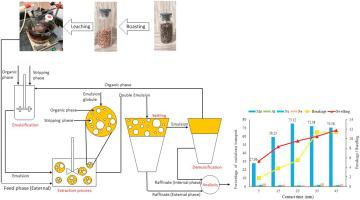Chemical Engineering and Processing: Process Intensification ( IF 4.3 ) Pub Date : 2020-05-29 , DOI: 10.1016/j.cep.2020.107958 Seyed Hamid Reza Rouhani , Reza Davarkhah , Parisa Zaheri , Seyed Mohammad Ali Mousavian

|
In this study, the selective extraction of molybdenum (Mo) from the spent hydrodesulfurization (HDS) catalysts using emulsion liquid membrane method was investigated. Cyanex 272 and ammonium fluoride (NH4F) had excellent efficiency in selective extraction of Mo from the spent catalysts as extractant and stripping agent, respectively. Other parameters including surfactant concentration, speed of agitation, contact time, treat ratio (external to emulsion phase volume ratio), and internal to membrane phase volume ratio were effective on the performance of the emulsion liquid membrane system. Besides, the stability of emulsion was determined by specifying the emulsion breakage and swelling at each stage. The optimal separation of Mo under operating conditions consists of 0.3 M Cyanex 272, 3 %wt. Span 80, 1 M ammonium fluoride, 25 min contact time with the agitation speed of 350 rpm, treat ratio of 2.5 and, internal to membrane phase volume ratio of one was obtained. Under these conditions, more than 75 % of the Mo was selectively transferred to the internal phase.
中文翻译:

使用乳液液膜系统从废HDS催化剂中分离钼
在这项研究中,研究了使用乳液液膜法从废加氢脱硫(HDS)催化剂中选择性萃取钼(Mo)。Cyanex 272和氟化铵(NH 4F)在分别从废催化剂中选择性地提取钼作为萃取剂和汽提剂方面具有优异的效率。其他参数包括表面活性剂浓度,搅拌速度,接触时间,处理比例(外部与乳液相的体积比)和内部与膜相的体积比对乳液液体膜系统的性能有效。此外,通过指定各阶段的破乳和溶胀来确定乳状液的稳定性。在工作条件下,Mo的最佳分离度为0.3 M Cyanex 272,3 wt%。跨度为80,1 M氟化铵,接触时间为25分钟,搅拌速度为350 rpm,处理比为2.5,内部与膜相的体积比为1。在这种情况下



























 京公网安备 11010802027423号
京公网安备 11010802027423号